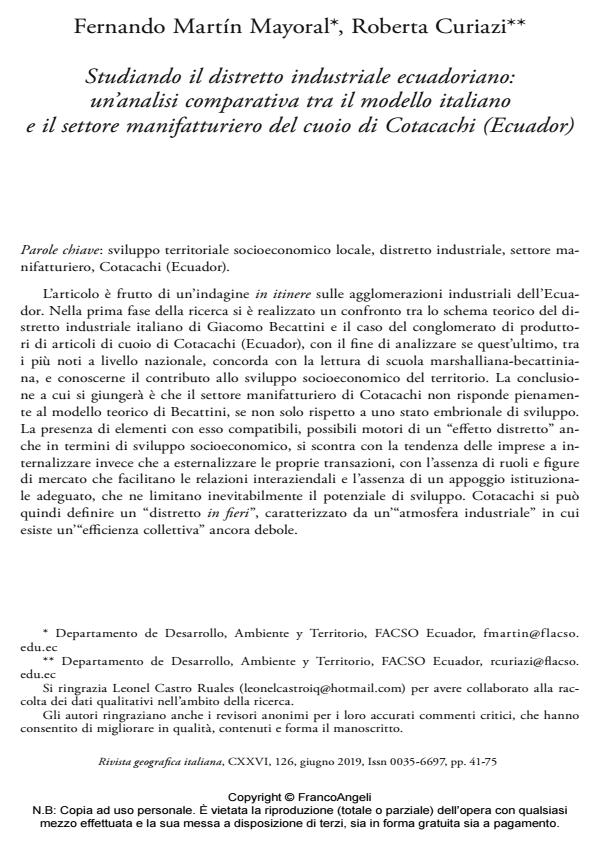Studying the Ecuadorian industrial district: a comparative analysis of the Italian industrial district model and the leather manufacturing sector in the city of Cotacachi (Ecuador)
Journal title RIVISTA GEOGRAFICA ITALIANA
Author/s Fernando Martín Mayoral, Roberta Curiazi
Publishing Year 2019 Issue 2019/2
Language Italian Pages 35 P. 41-75 File size 296 KB
DOI 10.3280/RGI2019-002003
DOI is like a bar code for intellectual property: to have more infomation
click here
Below, you can see the article first page
If you want to buy this article in PDF format, you can do it, following the instructions to buy download credits

FrancoAngeli is member of Publishers International Linking Association, Inc (PILA), a not-for-profit association which run the CrossRef service enabling links to and from online scholarly content.
The paper is part of an ongoing research on the industrial agglomerations of Ecuador. In the first phase of the investigation a comparison is made between the theoretical scheme of the Italian industrial district of Giacomo Becattini, and the case of the conglomerate of leather articles of Cotacachi (Ecuador), to analyze if the latter, among the best known at a national level, agrees with the reading of the Marshallian-Becattinian school, and to know its contribution to the socio-economic development of the territory. The conclusion to be reached is that the manufacturing sector of Cotacachi does not fully respond to the model of Becattini, if not only to an embryonic phase of development. The presence of elements compatible with it, and possible engines of a "district effect" even in terms of socio-economic development generated so far in the territory, clashes with the tendency of the firms to internalize rather than outsourcing their transactions, the absence of market roles and figures that facilitate inter-company relations and, finally, the absence of adequate institutional support, which inevitably limit its development potential. Cotacachi can therefore be defined as a "district in fieri", characterized by an "industrial atmosphere" in which there is still a weak "collective efficiency".
Keywords: Local socio-economic territorial development, industrial district, manufacturing sector, Cotacachi (Ecuador).
- Geopolitical Perspectives from the Italian Border Christian Sellar, Gianfranco Battisti, pp.3 (ISBN:978-3-031-26043-8)
Fernando Martín Mayoral, Roberta Curiazi, Studiando il distretto industriale ecuadoriano: un’analisi comparativa tra il modello italiano e il settore manifatturiero del cuoio di Cotacachi (Ecuador) in "RIVISTA GEOGRAFICA ITALIANA" 2/2019, pp 41-75, DOI: 10.3280/RGI2019-002003